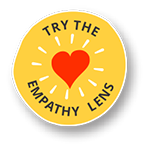Client Projects
Blurring the boundaries between school and real life
Try the empathy lens:
Think of a difficult administrative task that you have to complete (e.g. scheduling for the week, or organizing and managing classroom resources) and instead give it to a group of students.
Notice their behaviour and body language through the task. Ask them what they learnt from the task, and focus on how this learning and this task differed from completing an exercise in the textbook.
We experienced
That most of our learning came from experiences in the real world, yet we were primarily teaching students in the classroom.
Watch Kiran talk about where this idea originated, and the first Client Project that she gave her students.
Our Insights
- On reflection, we recognised that for us as teachers, our most transformative learning had come from our real life experiences rather than from our time spent in an academic classroom.
- We saw that children were much more engaged in the learning process whenever we could make it relevant to them and whenever they felt they were actually adding value to the world around them.
- We realised that when there was the presence of a real world Client, the children forgot that they were in school at all, so absorbed were they in the process of solving the clients need!
We thus recognised that Client Projects could be a fantastic way to help the students develop 21st Century skills, while at the same time covering academic content of Language, Maths and other core subjects.
it was possible for children to engage with learning in a manner that is relevant to the real world?
We designed
A process called Client Projects which gives children the opportunity to design solutions for real-life clients.
As they immerse themselves in understanding and fulfilling their client’s brief, children experience what it means to practice the FIDS process in real-time in the real-world.
They learn the responsibility of working with a user as they make choices that exercise skills like dividing tasks and working in teams, building empathy and understanding perspectives of different stakeholders.
Students also learn to think creatively and understand the pressure of implementing their solutions in the face of approaching deadlines.
At its core, a Client Project is an intentional way to activate the design-thinking mindset in children, and is one of the key elements that allows Riverside to prepare its students for life, and not just for college.
Here is What we Do
This video helps make visible the process of Client Projects from ‘intention’ to ‘action’.
In the video above, you will see the different steps for facilitating a Client Project, starting with identifying a client, understanding their needs and then ideating, creating and testing a prototype. You will also see the benefits that come from students’ exposure to different Client Projects.
Additional Videos:
-
5:38
a) Case Study 1: Jewellery Design
Watch students of Key Stage 1 showcase how age has nothing to do with competency.
-
3:54
b) Case Study 2: Butterfly Garden
Follow the students of Grade 4 in their journey of creating a new space for a local nature park.
-
2:50
c) Case Study 3: Havmor Challenge
Students of Grade 10 create a new flavour of ice cream for the festive season.
Meet the Stakeholder:
Eduhero Deepa Avashia is a school leader who works with students all across Key stage 3 in classes, congloms and one-on-ones. She is an expert administrator and teacher trainer, and has participated in over 20 client projects in her time at Riverside
-
4:22
FAQ Video
Watch her share important guidelines, strategies, and tips for facilitating Client Projects.
-
2:58
Impact Video
Watch Deepa share the impact that Client Projects have had on students as well as on her own practice.
Tips for the Leader
- The easiest way to start a Client Project is to tap into your network of friends and inquiring about their needs – it could be organizing a birthday party, or creating a library for a school, or designing an extension to a house, or even coming up with a new way to market an existing product.
- Be shameless about suggesting that your students might be the best people to design solutions for any needs, as you will be amazed about what they are capable of creating when given the chance!
- Make sure that your teachers understand the delicate balance of when to intervene/scaffold and when to let the students try to tackle an issue on their own. Tell your teachers that failure and reflection on that is a key part of the client projects process.
Share with us your experience of how you have used this process in your context, any challenges you might have faced or just inspire us with your story :-)
Still Curious?
Write us any questions you have about this process, and we’ll get back to you.
Want Feedback
Upload a glimpse of your practice - a classroom video & photos of plans, resource sheets and we’ll get back to you.
Zip all your photos into one file and upload the file here
Want to Inspire ?
Upload your school’s practice as a case study to share with the world!
Document and shoot your practice in an manner that people can understand. The video should not be more than 3-5 mins.

